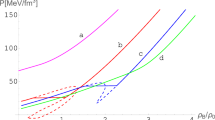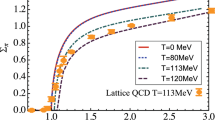Summary
The mesons in the nucleon are associated with a Bose system with an energy excitation spectrum ε(p), wherep is the corresponding momentum. This spectrum can be investigated by studying the nucleon recoil in one-meson production processes. It turns out that\(\mathop {\lim }\limits_{p \to 0} (\varepsilon /p) \ne 0\). This is the Landau criterion for superfluidity. Herefrom we infer that hadronic matter is superfluid. Possible manifestations of this phenomenon in strong interactions are a bootstrap relation between the masses of mesonic and baryonic resonances, the shift of the δ-resonance in nuclei, the existence of a maximum resonance mass equivalent to an ionization point and the existence of a critical temperature of hadronic matter instead of a maximum temperature.
Riassunto
I mesoni nel nucleone sono associati per mezzo di un sistema di bose con uno spettro di energie di eccitazione ε(p), dovep è l'impulso corrispondente. Si può analizzare questo spettro studiando il rinculo del nucleone nei processi di produzione di un mesone. Risulta che\(\mathop {\lim }\limits_{p \to 0} (\varepsilon /p) \ne 0\). Questo è il criterio di landau per la superfluidità. Da ciò si inferisce che la materia adronica è superfluida. Possibili manifestazioni di questo fenomeno nelle interazioni forti sono una relazione di bootstrap fra le masse delle risonanze mesoniche e barioniche, lo spostamento della risonanza δ nei nuclei, l'esistenza di una massa massima della risonanza equivalente ad un punto di ionizzazione e l'esistenza di una temperatura critica della materia adronica invece di una temperatura massima.
Резюме
Мезоны в нуклоне связываутся с Гозе-системой с энергетическим спектром возбуждения ε(p), гдеp есть соответствующии импульс. Этот спектр может быть исследован посредством изучения отдачи нуклона в процессе рождения одного пиона. Оказывается, что\(\mathop {\lim }\limits_{p \to 0} (\varepsilon /p) \ne 0\). Это представляет критерий Ландау для сверхтекучести, из которого мы делаем вывод, что адронное вещество является сверхтекучим. Возможные проявления этого явления в сильных взаимодействиях представляют: соотношения бутстрепа между массами мезонных и барионных резонансов, сдвиг δ резонанса в ядрах, существование резонансной массы, эквивалентной точке ионизации, и существование критической температуры адронного вещества вместо максимальной темпатуры.
Similar content being viewed by others
References
K. Galloway, A. Mann andR. Weiner:Lett. Nuovo Cimento,2, 248, 1295 (1971).
T. T. Chou andC. N. Yang:Phys. Rev. D,4, 2005 (1971).
L. D. Landau andE. M. Lifshitz:Statistical Physics, II Edition, Sect.67 (Reading, Mass., 1969).
A comprehensive list of references on the theory of superfluidity can be found inJ. Wilks:Liquid and Solid Helium (Oxford, 1967);W. E. Keller:Helium 3and Helium 4 (New York, 1969).
The idea of two kinds of motion originates in L. Tisza's 2-fluid model (L. Tisza:Nature,141, 913 (1938).
F. Binon, P. Duteil, J. P. Garron, J. Gorres, L. Hugon, J. P. Peigneux, C. Schmit andM. Spigel:Nucl. Phys.,17 B, 168 (1970).
A list of publications along these lines can be found.
M. Locher, O. Steinmann andN. Streumann:Nucl. Phys.,27 B, 598 (1971).
T. Ericson andJ. Hüfner:Phys. Lett.,33 B, 601 (1970).
A short account of the contents of this Section has been published inLett. Nuovo Cimento,2, 248 (1971).
It is interesting to mention that the possibility of the existence of a maximum mass of hadrons has been suggested in a completely different context byD. Horn:Phys. Lett.,31 B, 30 (1970).
R. Hagedorn:Suppl. Nuovo Cimento,3, 147 (1965);Nuovo Cimento,56 A, 1027 (1968);Suppl. Nuovo Cimento,6, 311 (1968).
S. Frautschi:Phys. Rev. D,3, 2821 (1971).
A. Krzywicki:Phys. Rev.,187, 1964 (1969); other publications along these lines are quoted.
R. Hagedorn:Nuovo Cimento,56 A, 1027 (1968).
K. Imaeda:Lett. Nuovo Cimento,1, 290 (1971).
Author information
Authors and Affiliations
Additional information
Supported in part by the U.S. Army Research Office, Durham, N. C.
Supported in part by the National Science Foundation.
Traduzione a cura della Redazione.
Перевебено ребакциеИ.
Rights and permissions
About this article
Cite this article
Mann, A., Weiner, R.M. Superfluidity of hadronic matter. Nuov Cim A 10, 625–640 (1972). https://doi.org/10.1007/BF02899764
Received:
Published:
Issue Date:
DOI: https://doi.org/10.1007/BF02899764




